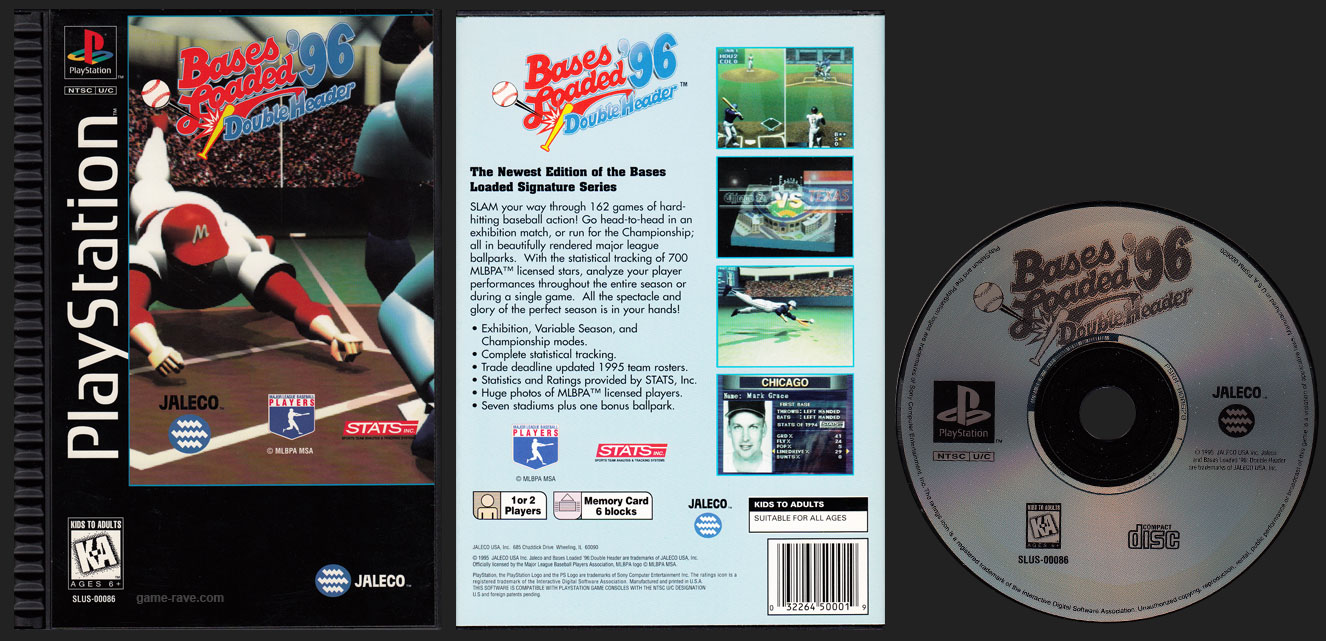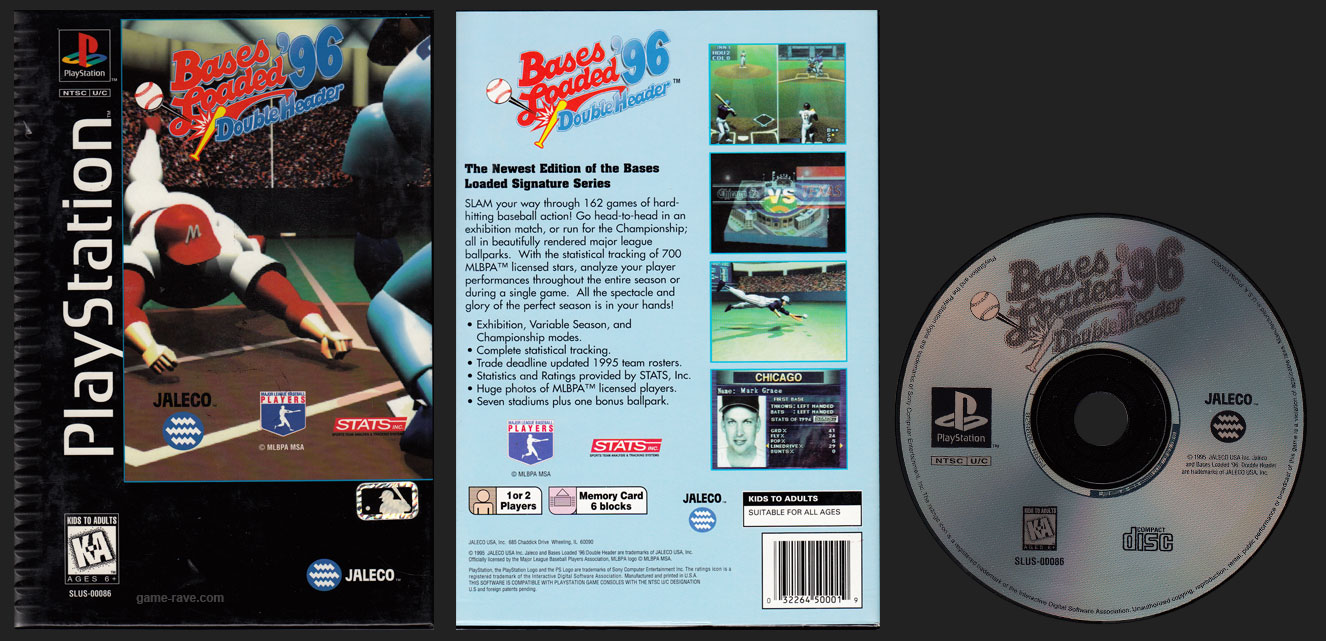| Genre: Baseball |
CDs: 1 |
|---|---|
| Publisher: Jaleco |
Released: December 22, 1995 |
| Developer: Jaleco |
UPC: 0 32264 50001 9 |
| Sony ID: SLUS-00086 |
PSRM: 000620 |
| Players: 1 to 2 Players |
Memory: 6 Blocks |
| Accessories: None |
|
| ESRB: Kids to Adults – No Descriptors |
|
| Box Copy:
The Newest Edition of the Bases Loaded Signature Series SLAM your way through 162 games of hard hitting baseball action! Go head-to-head in an exhibition match, or run for the Championship; all in beautifully rendered major league ballparks. With the statistical tracking of 700 MLBPA licensed stars, analyze your player performances throughout the entire season or during a single game. All the spectacle and glory of the perfect season is in your hands!
|
|
Review
Just because you’re the first at something doesn’t mean you’ll be the best at it. This holds true for the first baseball game to arrive on the American PlayStation – Bases Loaded 96: Double Header.
Double Header, both a term meaning to play two games of baseball back to back, might also be a cheeky nod to it being the first time Bases Loaded was released on two rival systems in the same era. Previously it was strictly just on the NES and Super NES, with a port to the original Game Boy. This final chapter in the series ended up on the Sega Saturn and the Sony PlayStation.
Bases Loaded 96 is a bit of a misnomer, as the game was released in 1995 with rosters official through that year’s trade deadline. There are 700 officially licensed baseball players across all generically named sports teams. Every team is represented, but it’s just their cities you get to see on the scoreboard. Seven fictional stadiums are playable, six of which are clearly their unnamed real-life counterparts along with a bonus ballpark to round out the basic festivities.
Once into the main game, players have the obligatory one-off exhibition game, get to play in the championship series, or set-up their own custom season. If like me, gamers can have fun with the 13-game season, or choose from 26, 52, or the full 162 games of regulation. Once they’ve chosen your destiny, would-be hall-of-famers can set-up trades before starting, or go head first and play with the cards you’re dealt.
The game does keep track of your season stats, allowing you the chance to swap in players, make substitutions during the game, and yank those players who just can’t get the offense going. Me being me, I played with the Cubbies, and I can assure you Sammy Sosa spent most of his time on the bench, even if it was my fault for swinging at every pitch.
With everything in its place, it’s finally time to PLAY BALL! The seven stadiums are rotated in and out as the season goes on, so if one decides they’re in it for the long ball…er…haul…they’ll regretfully become accustomed to their surroundings fairly quickly. With that in mind, it’s time to discuss the 500-pound elephant in the room – the game’s visual style.
Bases Loaded always had something unique going for it. Whether it was seeing the catcher’s hand move to catch the ball, or the reverse camera angle in volume 4, one could always expect something different from it. Here on the PlayStation and Saturn, that gimmick is a bit more unrefined.
The camera angle comes in three stages; batting, pitching, and fielding. The third-place camera uses the then standard-at-the-time sprite-based players on a 3D background. It’s in the close-up of batting and pitching that things take a curious turn. The background visuals are still essentially sprite based, but the player sprites are now 2D versions of 3D models – Think Donkey Kong Country and Killer Instinct. At first, it’s particularly jarring to swap between the visual styles, but as time goes on one pretty much gets used to it.
What the real issue here is the visual style of the players. Their animation is fantastic, but Jaleco did nothing to smooth out the rough polygon effects that early 3D modelling suffered from. This lack of touch-ups causes the batter and pitcher to look like they’re wearing diapers. All it would have taken was the smallest of post-production touch-ups to make it work. Alas, it’s Pampers from here on out.
Game play is standard fair for the genre, though here Jaleco allows the game to optionally handle running and fielding, so all the player must worry about is throwing and swinging. Players can make substitutions and the like, with little touches here and there sprinkled throughout.
The HUD will display the batter’s last attempts and the pitcher’s stamina. Pitchers have a limited pitch count, and would-be managers will need to plan their rotation accordingly. Having played baseball games on and off throughout the last 3 decades, Bases Loaded 96 is the first time I ever actually cared to figure out how to play manager. Sure, the duties are fairly thin compared to some of the crazy things modern day games offer, but to be simple enough for me to get into it speaks volumes. Speaking of volume, Bases Loaded has some interesting tweaks between its original Sega Saturn version and the later released PlayStation update.
In Sega’s incarnation, the game will visually call fair balls, where on the PlayStation it’s not present. Likewise, the Sega Saturn version will verbally call balls and strikes, but Sony’s version will only call out strikes. Fair guess would be either it was too quick of a port, or they left the audio clips out for space reasons with the PlayStation’s ram. As you would expect though, the PlayStation version has much better visuals, and not just because of the smoother stadium textures.
Sega’s version has a rather laughable problem in the outfield. If fielding a deep ground ball, players can clearly see there’s no background; no crowd, no city skyline, just black. Looks closer though, and it’s discovered that the crowd texture is on the same level as the grass texture. During a fly ball or potential homerun, if the ball is near the outer corners of the stadium, the Saturn version does a bizarre switch between two different camera planes to give the effect that the crowd is indeed as high as they should be. Most of the time it’s subtle, but if it’s a corner pocket shot, you’ll see the entire stadium rotate like a Tetris piece before swapping camera planes.
One last bit of curiosity between the two is that the Saturn’s field camera is hilariously close to the action, more than likely to hide the lack of outside world. The PlayStation version is pulled way back, allowing for easy view of all the action. It’s a wild set of trade-offs that, between the two, neither is the clear winner in a comparative debate.
If there was anything truly eye-brow raising with Bases Loaded’s 32-Bit incarnation, it’s that the game is ridiculously even tempered. In my 13-game season, there was only one instance where it felt like there could be rubber-banding issues, except it was on both sides of the pitch. In the first inning, the computer scored 3 runs off of my best pitcher. Half-way through the 5th inning, the computer suddenly caused 2 errors and wouldn’t pull their starter, allowing me to easily tie the game.
5 of the final 6 games played all went into extra innings, including one that went the full 18 innings maximum that if reached, the game is called and you must replay the entire single game series over again. Sadly, despite my noble first place ranking through most of the season, my final three games ended in losses, and my Cubbies were sent packing. Said season lasted about 30 minutes to an hour-and-a-half per game based on the amount of innings played, so having clocked in an easy 15 hours of game time through a completed season, I can add another PlayStation pile to the completed games list.
When it comes to reviewing Bases Loaded 96, especially 20 years after the fact, it can best be described as an unintentional remaster of the NES originals. It does what it needs to do, gets the job done with minimal pomp and circumstance, and is easy enough for even non-sports folk like myself to enjoy it.
The Good
- Super easy to pick up and play.
- Simple enough back end to allow everyone a chance at managing.
- Fast paced game play.
The Bad
- Art styles conflict with each other.
- Even tempered difficulty can lead to a lot of extra innings played.
- Missing or bizarre features on either platform.
Final Score: 5 / 10 – Average
While it doesn’t do anything truly wrong, Bases Loaded 96: Double Header also really doesn’t do anything spectacularly either.
Screenshots
- There are no screenshots for this game yet.
Videos
Trivia
- The 32-Bit version of Jaleco’s landmark baseball series proved to be too much, and was the final nail in the coffin for it. The game was released on both Saturn and PlayStation to confused reviews.
- Sega’s version has a laundry list of odd differences, including more audio, more on-screen calls, closer zoom in and other oddities.
- If you go 18 innings without breaking the tie, the game will forfeit the match and you will need to play it all over again.
Secrets
You can now literally control the game in Bases Loaded 96: Double Header with these Cheat Codes.
- Instant Home Run
Enable Cheat Mode by pausing the game and on controller 2 press Triangle, Square, Cross, Circle, Circle, Circle. You will hear a sound – now press L1 on controller 2. You will hear the game say, “Home Run”. From here every swing is a home run down center field. To disable, re-input the code. - Advance Innings
Enable Cheat Mode by pausing the game, and then on controller 2 pressing: Triangle, Square, Cross, Circle, Circle, Circle. After the sound, press Cross once. When you see “Let’s Go Inning” in the corner, change the inning by Pressing Cross on controller 2, then press Start. If the game is tied, you’ll be able to access extra innings. Note that in using this code, the game might flip which team you’re on. - Let the Computer Take Over
Enable Cheat Mode by pausing the game and on controller 2 press: Triangle, Square, Cross, Circle, Circle, Circle. After the piano sound, press L2 on Controller 2; you’ll hear a beep. Un-pause the game. To switch back to normal, re-enter the entire process.























